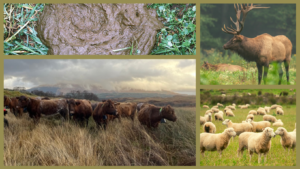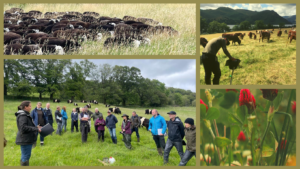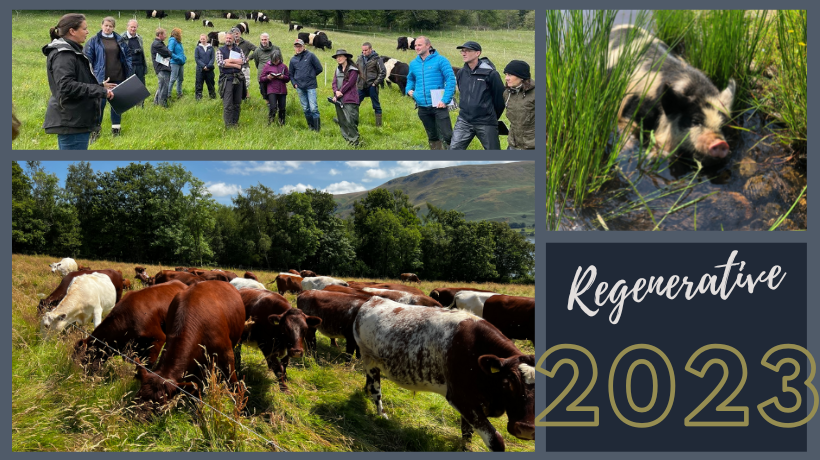Will Regenerative Agriculture be the hottest trend in 2023?
You can try and ignore it all you want, hoping everything will return to normal. Still, it’s impossible to ignore that not only do we now live in volatile, unpredictable, complex and ambiguous (VUCA) times but it is now being said we are in the midst of a so-called ‘polycrisis.’
In the polycrisis the shocks are disparate, but they interact so that the whole is even more overwhelming than the sum of the parts.
In such dark and uncertain times, it is tempting to bury your head and double down on what you know best, but this could be the worst thing to do. VUCA times require resilient mindsets and bold, brave, resilient businesses.
There is one system that has proved to be resilient for millennia – nature. We can learn from nature’s incredible resilience and adopt the principles that have allowed her to thrive through catastrophic events and dramatic climatic changes.
Regenerative agriculture is based on these principles of resilience and adaptability.
What is regenerative agriculture?
‘Regenerative agriculture is a system of farming principles and practices that increases biodiversity, enriches soils, improves watersheds, and enhances ecosystem services.
By capturing carbon in soil and biomass, regenerative agriculture aims to reverse current trends of atmospheric accumulation. At the same time, it offers increased yields, resilience to climate instability, and higher health and vitality for farming communities.’
-Terra Genesis
A different paradigm
Regenerative agriculture comes from a different paradigm to conventional and organic agriculture. It is a huge step change in how we produce our food.
Here are five factors that are true of regenerative agriculture;

It requires a holistic worldview
To fully understand and adopt regenerative agriculture, you must see the world as a living system of which you are part.
In regenerative agriculture, decisions are made ‘holistically’ considering the social, ecological and economic impact of choice, both short and long-term.
Holistic management is one way you may come to regenerative agriculture. By undertaking the training and using the holistic management framework, you develop the capacity to view the world from this paradigm.
Principles not practices
Regenerative agriculture is based on ecological principles. Practitioners learn ecological principles. With support, each farmer must take these principles and determine what tools and practices are appropriate for their unique context.
Some farmers may come into the movement from an interest in soil health or grassland productivity practices and follow a prescriptive plan. This may yield some regenerative outcomes, but if the principles and thinking behind the practices are not fully understood, results can be frustrating and limited.

Outcomes not standards
The only way to measure success in regenerative agriculture is to measure the outcomes. You don’t know if your practices are regenerative until you can see they have improved the ecosystem processes.
Ethan Soloviev (mentioned above) proposes; ‘that there is no such thing as a “Regenerative Agriculture Practice” — only systemic outcomes can confirm that regeneration is taking place.
Savory’s ‘Ecological Outcome Verification’ is a great way to prove that a product has been grown from a farm that is regenerating its ecosystems. It measures the improvements in ecosystem processes which allows management to be unique and ever-changing within each farm context.
Unique to people and place
So often in modern agriculture, we spend time and money treating symptoms. If a problem re-occurs, then you have not got to the root cause of the matter.
Imagine if your car warning light starts blinking. Still, instead of talking to the mechanics to investigate the potential problem, you simply tape over the annoying light so that it no longer distracts you. That’s what we are doing in many of our conventional farming systems.
If every year you have to treat for internal parasites, spray for thistles and bolus with trace minerals, then there is a fundamental problem with your farming system.
In regenerative agriculture, we carefully look for the root cause of such symptoms such as poor soil health, a simplified ecosystem, livestock that have been selected for the wrong genetic traits etc. In addition to a necessary holding action, we ensure, we then adapt our management to try and prevent the issue from reoccurring.
Regenerative agriculture is a ‘poly solution.’ It benefits form whole system function – the results are greater than the sum of its parts. Caroline Grindrod
The regenerative agriculture movement has been a slow and arduous building of decades of pioneering work in the face of ridicule and resistance from those with an invested interest in the status quo.
Pioneers such as Allan Savory, Gabe Brown and the understanding AG team, Vandana Shiva, the Regrarians, the Permaculture movement and many others (including Roots of nature, 3LM, Rob Havard, Wilderculture and others here in the UK) have done the excruciatingly hard work of rolling the boulder up the very steep hill to reach the tipping point that is about to crash down on us.
Collectively these pioneers have demonstrated success with practical examples on millions of acres and scientifically collected indisputable evidence that regenerative agriculture works.
“First they ignore you, then they laugh at you, then they fight you, then you win” originated with Mahatma Gandhi.
Regenerative agriculture – reaching a tipping point in 2023
This is a movement whose time has come.
During the turbulent last few years filled with rapidly rising costs, disrupted supply chains, biodiversity collapse and climate derangement, regenerative agriculture seems to be the only serious contender for a more resilient and healthy future for people and the planet – unless, of course, you have been seduced by George Monbiot’s depressing dystopian future of factory formed fake food!

It’s time for farmers to step up and take on the role of being a critical part of the solution to the polycrisis we face.
So if you are a farmer and relatively new to regenerative agriculture but are ‘regen curious’, then we have designed a #REGENUARY of inspiring and educational videos to get you up to speed. You’ll get a tour of some of the greatest names in the regenerative agriculture movement and learn loads about how regenerative principles could help your business thrive in the troubled times ahead.
Please share, and don’t forget to sign up for our mailing list (on the foot of the home page) to learn about new training offerings and much more.
| Adaptive multi-paddock grazing management’s influence on soil food web community structure for increasing pasture forage production, soil organic carbon, and reducing soil respiration rates in southeastern USA ranches | https://carboncowboys.org/images/published_research/pdfs/Johnson_et_al_Adaptive_Multi-paddock_Grazing.pdf |
| Soil carbon cowboys were years ahead of the game. Peter Byck’s fabulous films have inspired thousands of farmers to get interested in regenerative agriculture. | https://youtu.be/MDoUDLbg8tg |
| Kiss the ground is an inspiring and hopeful high-level view of regenerative agriculture and the potential solutions it offers. | https://kissthegroundmovie.com |
| Running out of time, featuring Allan Savory, offers a compelling insight into the scale and urgency of our climate challenges and inspiring solutions to how we can meet them. | https://youtu.be/q7pI7IYaJLI |
| Two early pioneers of regenerative grazing in the UK, Rebecca Hoskin and the late Tim Green, show us how they transformed Village Farm by properly managing sheep. | https://www.permaculture.co.uk/articles/living-with-the-land-part-3-building-soil-with-regenerative-agriculture/ |
| In this Groundswell talk Allan Savory explains why addressing the root cause and making holistic decisions is essential to being a good regenerative farmer. | https://youtu.be/-vILw12ecPM |
| Gabe Brown, legendary Rancher from Brown Ranch, North Dakota. Legendary Regenerative pioneer Gabe supports 17 enterprises on his 5,000 acres. | https://youtu.be/TLwsn8snsMc |
| During the drought from the soil carbon cowboys is a great short video explaining how we can create drought through conventional farming practices. | https://youtu.be/w0cGRKwP9W8 |
| Dr Elaine Ingham, Soil Microbiologist and Founder of Soil Foodweb inc blows minds with her biological approach to soil health. | https://youtu.be/x2H60ritjag |
| Soil ecologist Dr Christine Jones on how we can build new topsoil through the liquid carbon pathway. | https://youtu.be/C3_w_Gp1mLM |
| Kristine Nichols, a soil scientist with USDA’s Agricultural Research Service talks about a biological approach to soil health. . | https://youtu.be/C6xDfl_G8js |
| I sell sunshine and water. One of my favourite regenerative grazing short films. | https://youtu.be/LqsL4SsEge0 |
| Soil ecologist Christine Jones clearly outlines why the use of inorganic nitrogen in agriculture is a highly inefficient – and polluting – practice. | https://youtu.be/rIXqmksTUQQ |
| We don’t have a Phosphorus shortage, we have a soil fungi shortage! Dr. Christine Jones, leading soil ecologist from Australia, discusses the Phosphorus Paradox. | https://youtu.be/Yv288F4TXbo |
| The principles of regenerative soil systems with the legendary agroecologist Nicole Masters. | https://youtu.be/KLiR0PjzA8k |
| The humble and great Greg Judy explains his simple steps to heal a previously overgrazed farm. | https://youtu.be/I25g8zeeMXM |
| The magic of herd impact. This carbon cowboy film is a funny and informative way to learn about the power of animal impact. | https://youtu.be/EBTINtTcBbE |
| Adaptive grazing hero Alan Williams with part one of this incredibly informative webinar on regenerative grazing. | https://youtu.be/AKIUxureqvM |
| Adaptive grazing hero Alan Williams with part two of this incredibly informative webinar on regenerative grazing. | https://youtu.be/7lcXWNO2Ero |
| Adaptive grazing hero Alan Williams with part three of this incredibly informative webinar on regenerative grazing. | https://youtu.be/7McbvDrJyu0 |
| Dr Jonathan Lungren gives a spirited and incredibly compelling explanation on why we need biodiversity for services and functions on a profitable regenerative farm. | https://youtu.be/FvjM70xiwZg |
| Alan Williams on the mindblowing world of epigenetic effects and why it matters to a profitable and productive regenerative livestock operation. | https://youtu.be/Y4dBxRAhjAQ |
| My favourite Scientist Dr Fred Provenza on why plant or feed variety and choice is critical for a healthy and profitable livestock operation. | https://youtu.be/ncVJfZZ7bTM |
| Regenerative dairy, can it be done? Siobhain and her next level grazing is my preferred method for carefully transitioning highly productive dairy farms. | https://youtu.be/wR9c82Ptibk |
| crops transition with regenerative farming through stages of increasingly better health. The progression to better health restores the natural and biological abilities of the plant and demonstrates increasing immunity to soil and airborne pathogens, better resistance to insects, improved production of lipids leading to stronger cell membranes for tastier fruit with better shelf life, and more. | https://youtu.be/D1wJefaFrVI |
| The great speaker and soil health expert Ray Archeleta on changing our minds for better soil health and land regeneration. | https://youtu.be/MrBHIuz34k8 |
| Colin Seis gives us a great introduction to pasture cropping and the many advantages it can offer. | https://youtu.be/6nVbpFsTmKg |
| Fascinating insights from Johann Zeitsman on why our modern scientific cattle breeding is leading to unresilient and unprofitable livestock operations. | https://youtu.be/jeuRyDLnPsw |
| A step too far for many but welcome to the world of natural mob breeding for productivity and profitability in livestock operations. | https://youtu.be/HvnEPP-KDHQ |
| In recent years, the regenerative agriculture movement has grown in prominence, but it is often forgotten that regenerative agriculture is rooted in the long held wisdom and practices of indigenous and traditional peoples. | https://youtu.be/s_f5jxqiVBw |
| Soil and diverse cover crops. Become a ‘soil whisperer’ by watching this series of short films on soil health and diverse cover crops and benefit from 20 years of learning how to farm in nature’s image. | https://youtu.be/nNMdWnfjs8s |
